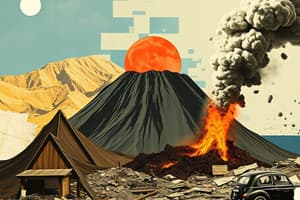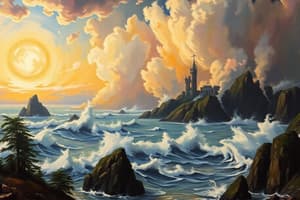Podcast
Questions and Answers
Which of the following natural disasters is classified as a geologic event?
Which of the following natural disasters is classified as a geologic event?
- Flood
- Tornado
- Hurricane
- Earthquake (correct)
In which situation would a significant earthquake not be classified as a disaster?
In which situation would a significant earthquake not be classified as a disaster?
- When it occurs over a large uninhabited area. (correct)
- When it occurs in a densely populated area.
- If it triggers landslides in populated regions.
- If it has a magnitude greater than 7.0.
Which of the following is NOT classified as a surface or exterior process?
Which of the following is NOT classified as a surface or exterior process?
- Volcanic activities (correct)
- Mass wasting
- Landslides
- Earthquake-induced tsunamis
Which event is NOT considered a natural hazard?
Which event is NOT considered a natural hazard?
Which of the following natural hazards does NOT generally result from earthquakes?
Which of the following natural hazards does NOT generally result from earthquakes?
What significant factor has contributed to climate change since the 1700s?
What significant factor has contributed to climate change since the 1700s?
What is the expected impact of increased Carbon Dioxide levels in the atmosphere?
What is the expected impact of increased Carbon Dioxide levels in the atmosphere?
Which natural hazard is characterized by a sudden movement of the Earth’s crust?
Which natural hazard is characterized by a sudden movement of the Earth’s crust?
What natural hazard is directly caused by a lack of precipitation?
What natural hazard is directly caused by a lack of precipitation?
What is the defining characteristic of tsunamis?
What is the defining characteristic of tsunamis?
Which natural hazard is least likely to be triggered by an earthquake?
Which natural hazard is least likely to be triggered by an earthquake?
What term describes a large storm system characterized by high-powered circular winds?
What term describes a large storm system characterized by high-powered circular winds?
Which of the following examples does not represent a natural system?
Which of the following examples does not represent a natural system?
Which factors are considered the main contributors to air pollution?
Which factors are considered the main contributors to air pollution?
Which of the following factors does not significantly affect the climate of a region?
Which of the following factors does not significantly affect the climate of a region?
What does the carbon category in the human footprint measure?
What does the carbon category in the human footprint measure?
Which of the following best describes built-up land in relation to human withdrawals?
Which of the following best describes built-up land in relation to human withdrawals?
Based on the trend in the Arctic sea ice extent graph, which description accurately characterizes the observed changes?
Based on the trend in the Arctic sea ice extent graph, which description accurately characterizes the observed changes?
If the downward trend of Arctic sea ice extent continues, what approach might researchers highlight for the July 2014 prediction?
If the downward trend of Arctic sea ice extent continues, what approach might researchers highlight for the July 2014 prediction?
What is the main focus of the definitions associated with human footprint categories?
What is the main focus of the definitions associated with human footprint categories?
What are the elements that constitute water?
What are the elements that constitute water?
Which statement about non-renewable resources is accurate?
Which statement about non-renewable resources is accurate?
Which of the following is an example of physical water scarcity?
Which of the following is an example of physical water scarcity?
Which alternative correctly identifies a consequence of land pollution?
Which alternative correctly identifies a consequence of land pollution?
Which of the following is not considered a renewable resource?
Which of the following is not considered a renewable resource?
Flashcards
Natural Disaster Components
Natural Disaster Components
Natural disasters often involve various events like earthquakes, floods, and volcanic activity.
Disaster vs. Large Event
Disaster vs. Large Event
A large event, like a significant earthquake, isn't a disaster if it affects a sparsely populated area with minimal human impact.
Natural Hazard Definition
Natural Hazard Definition
A natural hazard is a naturally occurring extreme weather event or geologic phenomenon that can negatively impact humans.
Interior Process Hazard
Interior Process Hazard
Signup and view all the flashcards
Surface/Exterior Process Hazards
Surface/Exterior Process Hazards
Signup and view all the flashcards
Natural hazard NOT caused by earthquake
Natural hazard NOT caused by earthquake
Signup and view all the flashcards
Hurricanes definition
Hurricanes definition
Signup and view all the flashcards
Natural systems examples
Natural systems examples
Signup and view all the flashcards
Main air pollution culprits
Main air pollution culprits
Signup and view all the flashcards
Climate NOT affected by this
Climate NOT affected by this
Signup and view all the flashcards
Climate Change Cause
Climate Change Cause
Signup and view all the flashcards
Carbon Dioxide Effect
Carbon Dioxide Effect
Signup and view all the flashcards
Landslide
Landslide
Signup and view all the flashcards
Tsunami
Tsunami
Signup and view all the flashcards
Volcanic Activity
Volcanic Activity
Signup and view all the flashcards
Human Footprint
Human Footprint
Signup and view all the flashcards
Carbon Footprint
Carbon Footprint
Signup and view all the flashcards
Cropland Footprint
Cropland Footprint
Signup and view all the flashcards
Built-up Land Footprint
Built-up Land Footprint
Signup and view all the flashcards
Arctic Sea Ice Extent
Arctic Sea Ice Extent
Signup and view all the flashcards
Climate Change Definition
Climate Change Definition
Signup and view all the flashcards
What makes up water?
What makes up water?
Signup and view all the flashcards
Land Pollution's Impact
Land Pollution's Impact
Signup and view all the flashcards
Non-Renewable Resource
Non-Renewable Resource
Signup and view all the flashcards
Renewable vs. Non-Renewable
Renewable vs. Non-Renewable
Signup and view all the flashcards




